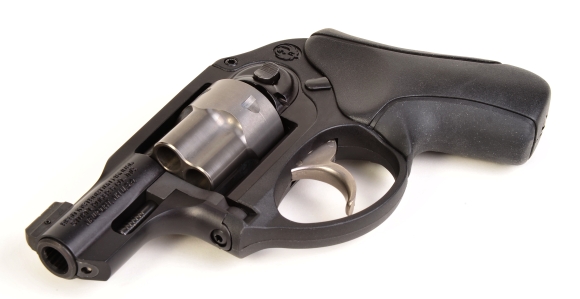
The Ruger LCR is a concealed hammer, snub nose, double action revolver. The LCR’s fire control housing, the non-stressed area that holds all of the trigger and cylinder indexing parts and provides a handhold for a shooter, is made of modern polymer construction. Yup, the same type of material that holds modern high power autoloaders together. The frame and cylinder locking areas are made of 7000 Series aluminum alloy. The barrel is made of 17-4 PH aerospace grade stainless steel. The cylinder is made of high strength stainless steel. The Hogue grip is made of injection molded, recoil absorbing synthetic rubber.
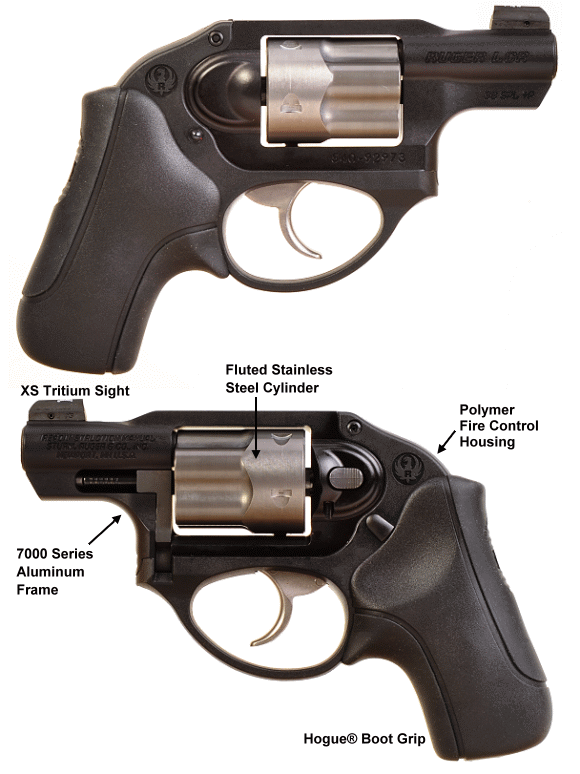
|
||||||||||||||||||||||||
Series 7000 aluminum is an aluminum – zinc alloy and highly resistant to stress corrosion cracking. Additionally, Series 7000 stainless may be precipitation hardened to give it the highest strength of any aluminum alloy. The .38 Special has a SAAMI maximum pressure of 17,000 PSI. The +P version of the cartridge is rated at 18,500. Combined with the high strength stainless cylinder and barrel, the Ruger LCR is listed as OK for a steady diet of .38 Special +P ammunition.
The Ruger LCR, as is the case with all revolvers, is subject to Newton’s first law, including that part about inertia at rest, or acute bulletpulliosis. Bullets in unfired chambers are the lazy component and only reluctantly follow their casings when under recoil. Subsequently, the use of ammunition with proper bullet crimping is essential.
Ruger has tested the gun with products from SAAMI spec manufacturers and found bullet pulling not to be a problem, so this is more of a potential issue with handloaders. When a revolver is discharged, the gun and casings tightly secured at the rim all move rearward…. very quickly. The bullets, the projectiles, in the unfired chambers tend to want to remain exactly where they are. If case crimps are not properly formed, the inertia of the bullet will overcome the grip of the crimp and the bullet will pull from its casing. Very light revolvers have higher recoil velocity and are a bit more sensitive to this dynamic… or as they say in Texas, dah-NAM-ics.
The folks at Ruger were kind enough to provide a simple test method to assure crimping is sufficient, regardless source of ammunition, within the LCR’s owner’s manual. Basically, the procedure calls for loading the gun’s cylinder with five rounds, then discharging the revolver four or five times by using and reloading only one chamber in the cylinder. When this is completed, the unfired rounds are removed and checked for bullet pulling. Now that was a real road trip of an explanation to address a very minor point. During the whole time I was shooting the gun, factory ammunition or handloads, this never became an issue.

For all of the poly and aluminum alloy, and even the very light weight, the Ruger LCR has a very solid feel; no rattles, shake or plastic feel. In fact, the little gun has a very substantial feel. I like that.
The cylinder is supported at the front latch pin, the cylinder stop and at the ejector. Cylinder lock up and release is… crisp. Indexing is positive and alignment, checked with a range rod, showed no signs of misalignment or timing problems.
The front sight is a nice touch and Tritium, like light pipes, are always welcome. For the most part, however, a snub nose revolver is a point and shoot proposition.

The Ruger LCR is very low maintenance to the point that only the one screw that secures the grip is removed to gain access to essential areas. A little wipe down and lube and checking some fasteners for tightness is the entire regimen for owner maintenance.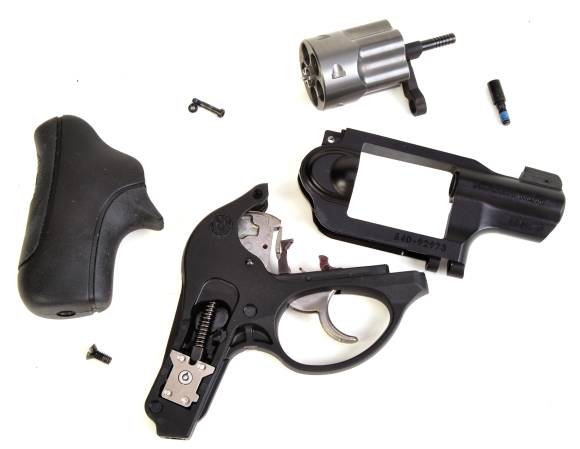
The manual notes that disassembly beyond removal of the grip should be handled by trained factory service personnel. The picture above makes two things clear; I obviously have a problem with reading comprehension and the LCR is very modular in design. The silver-colored block at the base of the grip peg is an internal lock. The key has an integral screw driver so it can be used to remove the grip screw to gain access to the internal lock keyway. Interesting… after grip removal, removal of a couple of Torx head fasteners at the front and top side of the frame allows the gun to come apart. The design seems simplified and part count reduced compared to those little hardware bits and springs that normally fall out when I disassemble a revolver. And, better yet, the LCR did go back together again as easily as it came apart.
The LCR as a carry or house gun…
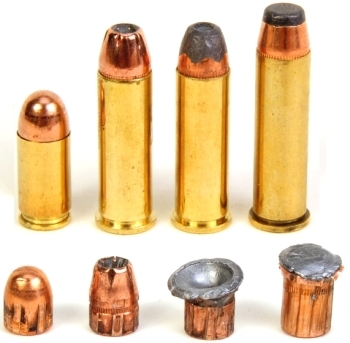 Not wanting to be lazy at this point, I did something I hate to do… besides eating broccoli, I put out some ballistics penetration test medium. For the sake of context, the Ruger LCR was compared to the .380 ACP and the 357 Magnum. Data appears on the table as the rounds appear, right.
Not wanting to be lazy at this point, I did something I hate to do… besides eating broccoli, I put out some ballistics penetration test medium. For the sake of context, the Ruger LCR was compared to the .380 ACP and the 357 Magnum. Data appears on the table as the rounds appear, right.
| Cartridge | Bullet Weight |
Type | Penetration |
| 380 ACP | 90 | FMJ | 8″ |
| 38 Special | 110 | JHP | 7″ |
| 38 Special | 125 | JSP | 8″ |
| 357 Magnum | 158 | JSP | 12″ |
The summary results make a pretty good case for the Ruger LCR and .38 Special +P loads. Penetration was good, expansion was good and accuracy was good.
The little Ruger LCP .380 actually did a good job on penetration, but with little expansion. Lightly loaded 110 grain .38 Special loads penetrated almost as well as the 125 grain 38 Special loads, but there was little expansion. The 125 grain loads were impressive in regard to penetration and controlled expansion. The .357 Magnum loads performed really well, but shooting this level of handgun load with proficiency requires lots of practice.
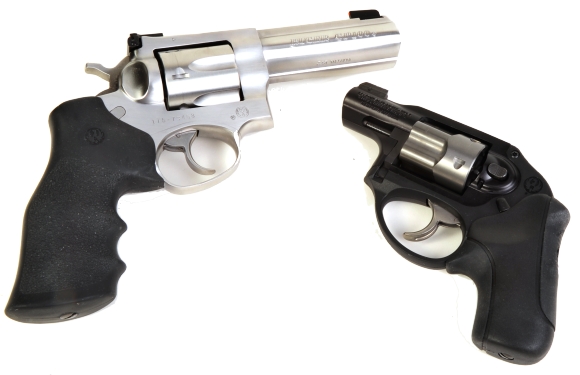
The LCR is compact and lightweight, enough so that it makes even the medium frame GP100 look… hefty; 13 oz in weight compared to 40 oz for the GP100. Despite the LCR’s light weight, after putting all sorts of ammo through the Ruger LCR, the absence of significant recoil was surprising – good grip material and design, and maybe the frame eats a bit of the recoil energy.
It took a little time to get used to the LCR’s sight picture as the front sight dot is supposed to be centered in the groove on the frame. It feels a little bit like… shooting down hill, but the point of impact, at least for the ammo I was shooting, worked out right. At ten yards, with a two-hand hold, it was easy to keep five shots in a three to four inch circle. Considering I am more lethal throwing my old S&W Model 37 Airweight than trying to shoot something with it, the LCR reflects a huge improvement. Coming soon, Part II will include handloads and greater quantification of the LCR’s accuracy and overall ballistic performance.
Taking a Jackie Wilson break….
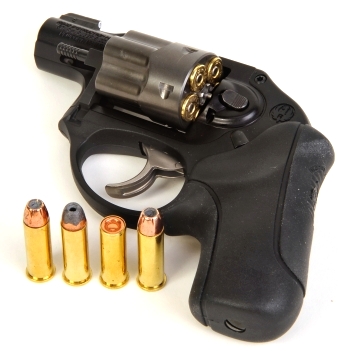
Love that song, “Lonely Tear Drops”. Good song writers wrote about the human condition. Unfortunately, I think they still do… which is probably why a hardly ever listen to the radio anymore. For now it’s a little of Roy Orbison’s “Crying”. A little 70’s Joe Cocker “Cry Me a River”… twice. Then wrapping it up with a little Hank Williams Sr. Now if only I could find that Cajun? Creole? band with the red headed lady in the evening gown I saw on Austin City Limits five years ago.
Yes, I am taking the long way around to saying the Ruger LCR is different enough and nifty enough to appear on a short list of modern guns to be appreciated and enjoyed. The gun has personality, its performance never disappoints and shooting it always concludes with a desire to shoot it some more.
Ruger’s LCR – LCR-BGXS Part I
Ruger’s LCR – LCR-BGXS Part II

Email Notification